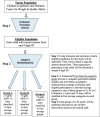Efficacy of metformin and fermentable fiber combination therapy in adolescents with severe obesity and insulin resistance: study protocol for a double-blind randomized controlled trial
- PMID: 33596993
- PMCID: PMC7890810
- DOI: 10.1186/s13063-021-05060-8
Efficacy of metformin and fermentable fiber combination therapy in adolescents with severe obesity and insulin resistance: study protocol for a double-blind randomized controlled trial
Abstract
Background: Accumulating evidence suggests that the metabolic effects of metformin and fermentable fibers are mediated, in part, through diverging or overlapping effects on the composition and metabolic functions of the gut microbiome. Pre-clinical animal models have established that the addition of fiber to metformin monotherapy improves glucose tolerance. However, possible synergistic effects of combination therapy (metformin plus fiber) have not been investigated in humans. Moreover, the underlying mechanisms of synergy have yet to be elucidated. The aim of this study is to compare in adolescents with obesity the metabolic effects of metformin and fermentable fibers in combination with those of metformin or fiber alone. We will also determine if therapeutic responses correlate with compositional and functional features of the gut microbiome.
Methods: This is a parallel three-armed, double-blinded, randomized controlled trial. Adolescents (aged 12-18 years) with obesity, insulin resistance (IR), and a family history of type 2 diabetes mellitus (T2DM) will receive either metformin (850 mg p.o. twice/day), fermentable fibers (35 g/day), or a combination of metformin plus fiber for 12 months. Participants will be seen at baseline, 3, 6, and 12 months, with a phone follow-up at 1 and 9 months. Primary and secondary outcomes will be assessed at baseline, 6, and 12 months. The primary outcome is change in IR estimated by homeostatic model assessment of IR; key secondary outcomes include changes in the Matsuda index, oral disposition index, body mass index z-score, and fat mass to fat-free mass ratio. To gain mechanistic insight, endpoints that reflect host-microbiota interactions will also be assessed: obesity-related immune, metabolic, and satiety markers; humoral metabolites; and fecal microbiota composition, short-chain fatty acids, and bile acids.
Discussion: This study will compare the potential metabolic benefits of fiber with those of metformin in adolescents with obesity, determine if metformin and fiber act synergistically to improve IR, and elucidate whether the metabolic benefits of metformin and fiber associate with changes in fecal microbiota composition and the output of health-related metabolites. This study will provide insight into the potential role of the gut microbiome as a target for enhancing the therapeutic efficacy of emerging treatments for T2DM prevention.
Trial registration: ClinicalTrials.gov NCT04578652 . Registered on 8 October 2020.
Keywords: Adolescents; Diabetes; Dietary fiber; Gut microbiome; Insulin resistance; Metformin; Obesity.
Figures



Similar articles
-
Long-term treatment with metformin in obese, insulin-resistant adolescents: results of a randomized double-blinded placebo-controlled trial.Nutr Diabetes. 2016 Aug 29;6(8):e228. doi: 10.1038/nutd.2016.37. Nutr Diabetes. 2016. PMID: 27571249 Free PMC article. Clinical Trial.
-
The effects of metformin on body mass index and glucose tolerance in obese adolescents with fasting hyperinsulinemia and a family history of type 2 diabetes.Pediatrics. 2001 Apr;107(4):E55. doi: 10.1542/peds.107.4.e55. Pediatrics. 2001. PMID: 11335776 Clinical Trial.
-
Metformin in women with type 2 diabetes in pregnancy (MiTy): a multi-center randomized controlled trial.BMC Pregnancy Childbirth. 2016 Jul 19;16(1):173. doi: 10.1186/s12884-016-0954-4. BMC Pregnancy Childbirth. 2016. PMID: 27435163 Free PMC article. Clinical Trial.
-
Repaglinide : a pharmacoeconomic review of its use in type 2 diabetes mellitus.Pharmacoeconomics. 2004;22(6):389-411. doi: 10.2165/00019053-200422060-00005. Pharmacoeconomics. 2004. PMID: 15099124 Review.
-
Efficacy and Safety of Metformin for Obesity: A Systematic Review.Pediatrics. 2021 Mar;147(3):e20201610. doi: 10.1542/peds.2020-1610. Pediatrics. 2021. PMID: 33608415
Cited by
-
The Need for Fiber Addition in Symptomatic Heart Failure (FEAST-HF): A Randomized Controlled Pilot Trial.CJC Open. 2023 Jul 18;5(10):760-769. doi: 10.1016/j.cjco.2023.07.005. eCollection 2023 Oct. CJC Open. 2023. PMID: 37876886 Free PMC article.
-
The Differences of Mechanisms in Antihypertensive and Anti-Obesity Effects of Eucommia Leaf Extract between Rodents and Humans.Molecules. 2023 Feb 18;28(4):1964. doi: 10.3390/molecules28041964. Molecules. 2023. PMID: 36838952 Free PMC article. Review.
References
-
- Group TS. Zeitler P, Epstein L, Grey M, Hirst K, Kaufman F, et al. Treatment options for type 2 diabetes in adolescents and youth: a study of the comparative efficacy of metformin alone or in combination with rosiglitazone or lifestyle intervention in adolescents with type 2 diabetes. Pediatr Diabetes. 2007;8(2):74–87. doi: 10.1111/j.1399-5448.2007.00237.x. - DOI - PMC - PubMed
Publication types
MeSH terms
Substances
Associated data
LinkOut - more resources
Full Text Sources
Other Literature Sources
Medical

